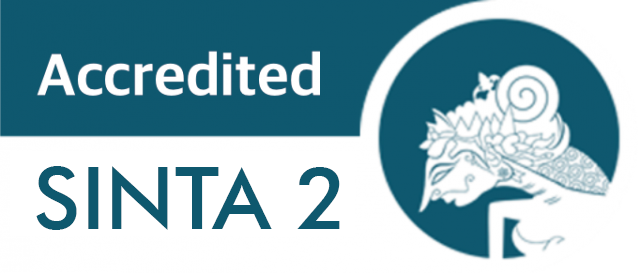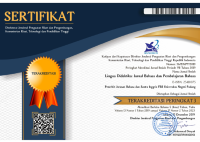AN ANALYSIS OF SPEAKING FLUENCY LEVEL OF THE ENGLISH DEPARTMENT STUDENTS OF UNIVERSITAS NEGERI PADANG (UNP)
 ),
), (1) Universitas Negeri Padang
 Corresponding Author
Corresponding Author
Copyright (c) 2017 Lingua Didaktika: Jurnal Bahasa dan Pembelajaran Bahasa
DOI : https://doi.org/10.24036/ld.v10i2.7417
Full Text:
 Language : en
Language : en
Abstract
ANALISA LEVEL KELANCARAN BERBICARA BAHASA INGGRIS PADA MAHASISWA JURUSAN BAHASA INGGRIS DI UNIVERSITAS NEGERI PADANG (UNP)
AbstractThe purposes of this study were to describe students’ fluency level and to identify students’ disfluency factors at the English Department Program of Universitas Negeri Padang (UNP). It employed quantitative research method with the class of 2011 students as the research population. There were 25 students taken as the research sample selected through simple random sampling technique. The data were collected through speaking test and a survey with a set of questionnaire. In the speaking test, students were allowed to choose one of five topics provided and were asked to deliver short talks for 2 minutes. These short talks were recorded digitally. In addition to the speaking test, there were 20 questions with four options as the answers. These questions represented five main factors of disfluency such as task with high difficulty, absence of meaning-focused, lack of time pressure, deficiency of planning and preparation, and repetition nonexistence. The collected data were mainly in the form of transcription texts mined from the recordings of the short talks as well as the answers fronm the questionnaire. The results of the study show that students’ fluency level at the English Department Program of UNP is good (level 3). However, the information on disfluency which prevented them to get a higher score were also identified. Some of the main disfluency factors were task with high difficulty, absence of meaning-focused and lack of time pressure.
Key words/phrases: Speaking, fluency, disfluency, disfluency factor
Abstrak
Tujuan penelitian ini adalah (1) mendeskripsikan kemampuan fluency mahasiswa Jurusan Bahasa dan Sastra Inggris dalam berbicara menggunakan bahasa Inggris, (2) mengetahui faktor-faktor disfluency yang mereka hadapi. Penelitian ini adalah penelitian deskriptif. Populasi penelitian ini adalah mahasiswa tingkat III Jurusan Bahasa dan Sastra Inggris tahun masuk 2011 Fakultas Bahasa dan Seni, Universitas Negeri Padang. Sampel penelitian ini berjumlah 25 orang yang dipilih dengan menggunakan teknik simple random sampling. Data dikumpulkan melalui dua instrumen yaitu tes speaking dan angket. Dalam tes speaking, mahasiswa diberikan lima topik untuk dipilih dan diminta untuk menyampaikan short talk selama dua menit untuk kemudian direkam dengan menggunakan perangkat lunak komputer. Selain itu, di dalam angket yang digunakan terdapat 20 pertanyaan dengan 4 opsi jawaban yang mana semua pertanyaan tersebut mencakup 5 aspek penyebab utama disfluency yaitu difficult task, not meaning-focused, the absence of time pressure, lack of planning and preparation, dan unrepeated task. Data penelitian ini berupa transkripsi dari rekaman short talk dan jawaban mahasiswa untuk angket yang telah dibagikan. Dari penelitian ini ditemukan bahwa kemampuan fluency mahasiswa di dalam berbicara bahasa Inggris adalah good atau berada pada level 3. Faktor-faktor penyebab disfluency yang dihadapi oleh mahasiswa mencakup tingkat kesulitan, aspek meaning-focused, dan batas waktu pengerjaan dari kegiatan speaking fluency.
Kata Kunci: Speaking, fluency, disfluency, disfluency factor
Keywords
References
Bailey, K. M. (2005). Practical English Language Teaching: Speaking. Singapore: Mc Graw Hill.
Bhat, S., H. Johnson. and R. Sproat. (2010). Automatic Fluency Assessment by Signal-Level Measurement of Spontaneous Speech. Illinois: University of Illinois.
Brown, H. Douglas. (2004). Language Assessment: Principles and Classroom Practices. New York: Pearson Education.
Cucchiarini, C. H. Strik. and L. Boves. (2002). Quantitative Assessment of Second language Learners’ Fluency: Comparisons Between Read and Spontaneous Speech (Unpublished Thesis). Nijmegen: University of Nijmegen.
Florez, M.A.C. (1999). Improving Adult English Language Learner’s Speaking Skills. Washington DC: ERIC Digest.
Gay, L. R. and P. Airasian. (2000). Educational Research: Competencies for Analysis and Application. New Jersey: Prentice Hall.
Harris, P. David. (1974). Testing English as a Second Language. New Delhi: Tattoo Mcgraw Hill Publishing Company Ltd.
Jong, N. de. and J. Hulstijn. (2009). Relating Ratings of Fuency to Temporal and Lexical Aspects of Speech. Amsterdam: Utrecht Institute of Linguistics.
Kormos, J. and Denes. M. (2005). Exploring Measures and Perceptions of Fluency in the Speech of Second Language Learners. Budapest: Eötvös Loránd University.
Luoma, S. (2004). Assessing Speaking. Cambridge: Cambridge University Press.
Nation, I. S. P. and J. Newton. (2009). Teaching ESL/EFL Listening and Speaking. New York: Routledge.
Resource P. (2009). Assessment of Speech: Fluency. Tennessee: The Tennessee Department of Education.
Richards, J. C. (2006). Communicative Language Teaching Today. Cambridge: Cambridge University Press.
Schmidt, R. (1992). Psychological mechanisms underlying second language fluency. Studies in Second Language Acquisition. Cambridge: Cambridge University Press.
Shipley, K.G.. and McAfee. J.G. (2004). Assessment in Speech-Language Pathology: A Resource Manual. New York: Thompson Learning.
Stockdale, D. Ashley. (2009). Comparing Perception of Oral Fluency to Objective Measures in the EFL Classroom (Unpublished Thesis). Birmingham: University of Birmingham.
Zhang, Shumei. (2009). The Role of Input. Interaction and Output in the Development off oral Fluency (CCSE English Language Teaching Journal). Vol. 2. No. 4. On December.
 Article Metrics
Article Metrics
 Abstract Views : 5614 times
Abstract Views : 5614 times
 PDF Downloaded : 2323 times
PDF Downloaded : 2323 times
Refbacks
- There are currently no refbacks.
Copyright (c) 2017 Lingua Didaktika: Jurnal Bahasa dan Pembelajaran Bahasa

This work is licensed under a Creative Commons Attribution-NonCommercial 4.0 International License.









